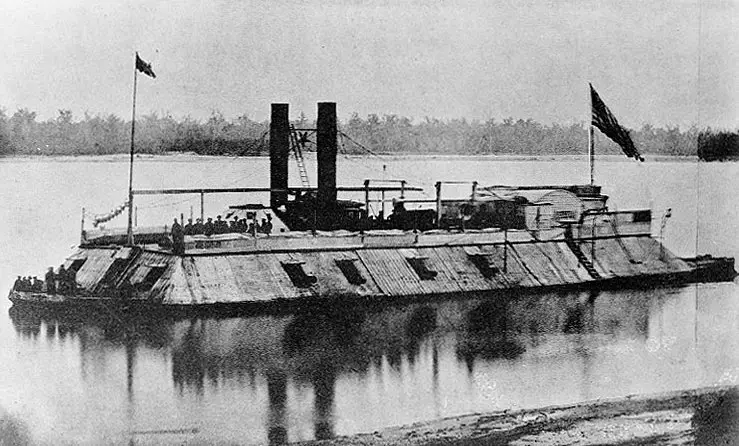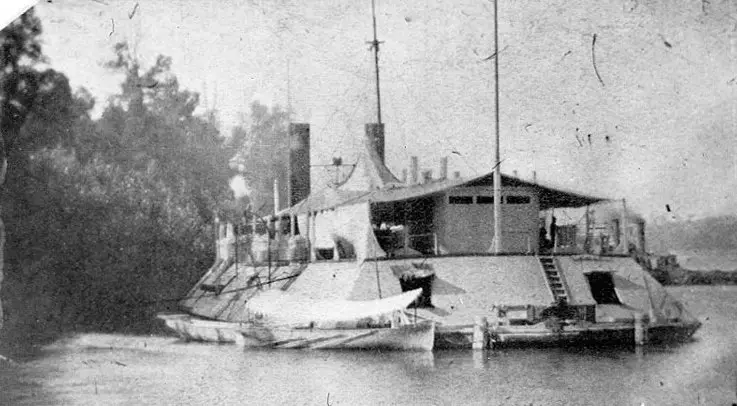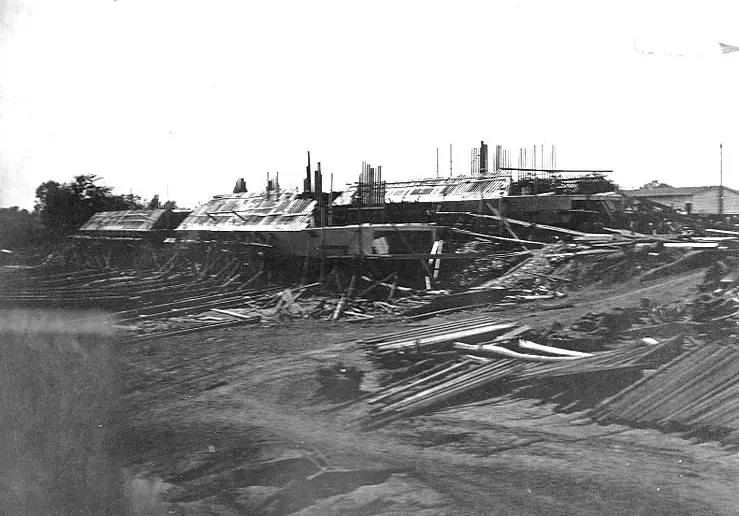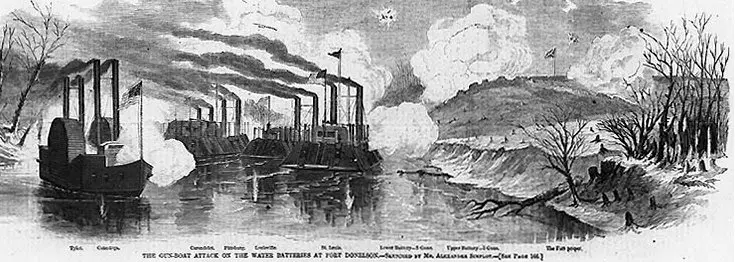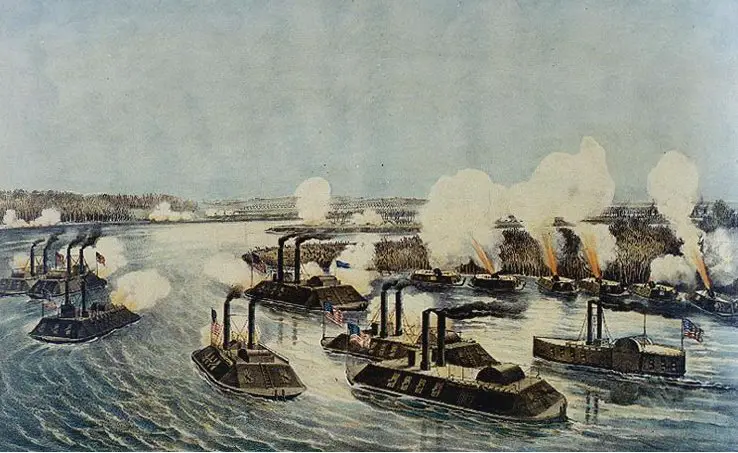USS Carondelet
Civil War Union Naval Ship
USS Carondelet (1862-1865)USS Carondelet , a 512-ton Cairo class ironclad river gunboat, was built at Saint Louis, Missouri, for the U.S. Army's Western Gunboat Flotilla. Commissioned in January 1862 with Commander Henry A. Walke , USN, as her captain, Carondelet quickly entered combat, taking part in the captures of Forts Henry and Donelson, Tennessee, in February 1862. In March and April, she played an important role in the campaign to capture the Confederate fortress at Island Number Ten, on the Mississippi River. This was followed by operations against Fort Pillow and Memphis, Tennessee, during April-June 1862. With the upper Mississippi now under Union control, Carondelet spent much of the following year in the long campaign against Vicksburg, Mississippi. On 15 July 1862, while in the Yazoo River, she was badly damaged in an engagement with the Confederate ironclad Arkansas . Along with the other units of the Army's Western Rivers "navy", she was formally transferred to the U.S. Navy in October 1862. In April 1863, Carondelet was a member of the ironclad force that ran past Vicksburg and later bombarded Grand Gulf, Mississippi. In May, she participated in extensive bombardments of Vicksburg, part of the combined Army-Navy operations that led to that fortified city's surrender on 4 July 1863. Thereafter, she was involved with a variety of expeditions and patrol operations, among them the March-May 1864 Red River expedition. Decommissioned in June 1865, USS Carondelet was sold in November of that year. Her hull was subsequently used as a civilian wharfboat, while her engines were installed in another river steamer. Photographed published in Rear Admiral Henry Walke's "Naval Scenes and Reminiscences of the Civil War in the United States ..." (1877). Seen from astern, tied up to the river bank, on the Western Rivers during the Civil War. |
 War, Technology, and Experience aboard the USS Monitor The experience of the men aboard the Monitor and their reactions to the thrills and dangers that accompanied the new machine. The invention surrounded men with iron and threatened their heroism, their self-image as warriors, even their lives  Confederate Ironclad 1861-65 Every aspect of Confederate ironclads is covered: design, construction, armor, armament, life on board, strategy, tactics, and actual combat actions Kindle Available  Naval Strategies of the Civil War: Confederate Innovations and Federal Opportunism Compare and contrast the strategies of the Southern Secretary of the Navy, Mallory, against his rival in the North, Welles. Mallory used technological innovation and the skill of individuals to bolster the South's seapower against the Union Navy's superior numbers |
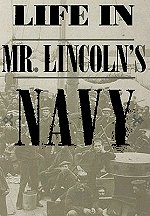 Life in Mr. Lincoln's Navy A tantalizing glimpse into the hardships endured by the naval leadership to build and recruit a fighting force. The seaman endured periods of boredom, punctuated by happy social times and terrifying bouts of battle horror  Confederate Phoenix The CSS Virginia The CSS Virginia of the Confederate States Navy destroyed two of the most formidable warships in the U.S. Navy. Suddenly, with this event, every wooden warship in every navy in the world became totally obsolete  Confederate Submarines and Torpedo Vessels 1861-65 Interesting information and many excellent illustrations. It addresses the CSA David class torpedo boats and the Hunley (and its predecessors), as well as Union examples such as the Alligator and the Spuyten Duyvil |
"City" Class armored gunboats This view looks along the main deck on one gunboat, with its boilers in the foreground and casemate timbers at the sides. Another vessel is beyond, with some spar deck beams atop the casemate side timbers and upright framing in place for her wheel box. "The Gun-boat Attack on the Water Batteries at Fort Donelson" Line engraving, based on a sketch by Alexander Simplot, published in "Harper's Weekly", 1862, depicting USS Carondelet passing the Confederate fortress at Island Number Ten, Mississippi River, during the night of 4 April 1862. She was accompanied by a coal barge, lashed to her port side to provide additional protection. Bombardment and Capture of Island Number Ten on the Mississippi River, April 7, 1862 |
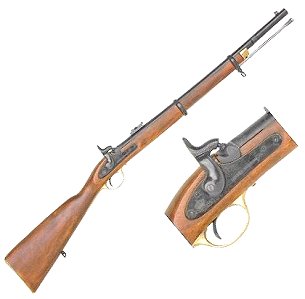 1860 Enfield Civil War Musketoon This piece is a full-size non-firing reproduction of the rifle used in the Civil War. The body is made of European hardwood  Civil War Cannon Collectible Models and childrens playsets Miniature Collectible Civil War Cannon12 pound Civil War field cannon replica weapon |
Civil War Ships and Battles Civil War Submarines RAM Ships Civil War Naval Timeline American Civil War Exhibits State Battle Maps Civil War Summary Civil War Timeline Women in the Civil War Battles by Campaign |
 Sid Meier's Civil War Collection Take command of either Confederate or Union troops and command them to attack from the trees, rally around the general, or do any number of other realistic military actions. 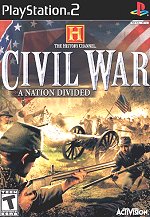 History Channel Civil War A Nation Divided Rally the troops and organize a counterattack -- Your strategic decision and talent as a commander will decide if the Union is preserved or if Dixie wins its independence |
Kindle Available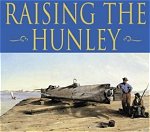 Raising the Hunley: The Remarkable History and Recovery of the Lost Confederate Submarine For more than a century the fate of the Hunley remained one of the great unsolved mysteries of the Civil War. Then, on August 8, 2000, with thousands of spectators crowding Charleston Harbor, the Hunley was raised from the bottom of the sea and towed ashore. |
Kindle Available Wolf of the Deep: Raphael Semmes and the Notorious Confederate Raider CSS Alabama In July 1862, the Confederate captain Raphael Semmes received orders to report to Liverpool, where he would take command of a secret new British-built steam warship. His mission: to prey on Union commercial vessels and undermine the North's ability to continue the war |
 Duel on the Roanoke The True Story of the CSS Albemarle A 158-foot Confederate ironclad ship built in a cornfield 90 miles up North Carolina's Roanoke River, under the direction of an 18-year-old boy, and the deadly cat-and-mouse game between the two opposing captains. |
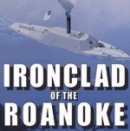 Ironclad of the Roanoke Gilbert Elliott's Albemarle The story of a Confederate Ironcald that was a powerful force until sunk by a Union Torpedo Boat after its brief stormy life. Ironic in the fact it was built in a Cornfield. Confederate Ingenunity at it finest! |
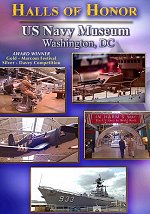 Halls of Honor The U.S. Navy Museum takes you on an informed and entertaining romp through one of North America s oldest and finest military museums. The museum has been in continuous operation at the Washington Navy Yard since the American Civil War |
 Raise The Alabama She was known as "the ghost ship." During the Civil War, the CSS Alabama sailed over 75,000 miles and captured more than 60 Union vessels. But her career came to an end in June of 1864 when she was sunk by the USS Kearsarge off the coast of Northern France |
 The Civil War - A Film by Ken Burns Here is the saga of celebrated generals and ordinary soldiers, a heroic and transcendent president and a country that had to divide itself in two in order to become one |
 Civil War Journal The Conflict Begins These four programs from the History Channel series Civil War Journal cover critical aspects of the early days of the war. |
Sources:
U.S. National Park Service
U.S. Library of Congress
US Naval Archives
| Search AmericanCivilWar.com |
| Enter the keywords you are looking for and the site will be searched and all occurrences of your request will be displayed. You can also enter a date format, April 19,1862 or September 1864. |

